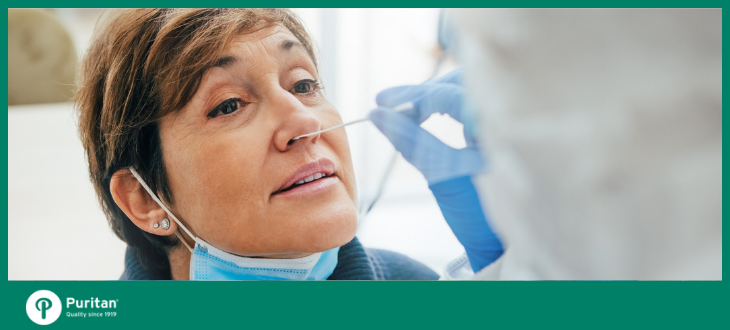
There remains a great deal of confusion and misinformation from the general population around the COVID nasal swab test. Healthcare providers can help boost the rates of critical testing by providing patients clear guidance around what to expect and how to prepare for this simple test.
By providing clear expectations, you can help put your patients at ease prior to their COVID nasal swab test.
When should you get a COVID-19 test?
Many of your patients are wondering when is the best time to get a COVID nasal swab test, particularly if they have no or few symptoms. According to the CDC, you should encourage individuals to take a COVID-19 test in the event that they meet one or more of the following conditions:
-
They are experiencing one or more symptoms of COVID-19, including fever or chills, cough, shortness of breath or difficulty breathing, new loss of taste or smell, fatigue, and muscle or body aches. The CDC provides a symptom tool on its website with a more inclusive list of symptoms.
-
They have had close contact with someone who has since been confirmed positive for COVID-19. Close contact includes within 6 feet for 15 minutes or more over a 24-hour period.
-
They are unvaccinated and have participated in an activity that puts them at higher risk for contracting COVID-19, such as attending large gatherings, traveling, or spending time in crowded and poorly ventilated facilities.
PCR vs Antigen Test for COVID-19
Diagnostic tests are used to gauge the presence of an active COVID-19 infection, but the available options offer different advantages to the test taker. Healthcare providers should help guide their patients to the appropriate test for their needs.
What is a PCR test?
A polymerase chain reaction (PCR) test is a molecular diagnostic test that measures a viral particle’s DNA material to determine if a person has an active infection. While false negatives are possible, these tests are considered highly accurate and the best option in the early stages of infection. Turnaround time for results, however, can take one to three days, or longer.
What is an antigen test?
An antigen test is a diagnostic test that measures virus proteins. These tests can provide results in as little as 15 minutes, but with varying degrees of accuracy. While positive tests are generally considered accurate, some medical experts advise following up on negative results with a PCR test due to the antigen test’s lower sensitivity
Both tests are typically conducted using either a nasal or nasopharyngeal swab, while some PCR tests can also be performed using a throat swab or saliva sample.
How to prepare for your COVID-19 test
Providers can prepare for the COVID-19 nasal swab test with a few simple steps:
-
Wash hands and don appropriate PPE, as required by your employer or recommended by the CDC.
-
Ask patients about recent nose or sinus problems, recent nose injuries or surgery, blood clotting disorders, or blood thinning medication, as this may increase the likelihood of mild complications including nosebleeds.
-
Aseptically remove the sterile swab from its packaging.
-
Tilt the patient’s head back slightly to straighten nasal passage prior to performing the COVID nasal swab test.
What to expect during your COVID nasal swab test
There are two common types of COVID tests, anterior nares (nasal) swab test and nasopharyngeal tests. It’s important that you offer clear expectations around the test to help put your patients at ease. Because COVID nasal swab tests are less invasive than nasopharyngeal tests, they are usually more comfortable for patients. The FDA recommends that symptomatic patients only perform nasal swab tests.
For this test, the CDC advises healthcare providers:
-
Insert the swab into the nostril 1/2- to 3/4-inch.
-
Slowly rotate the swab for 10 to 15 seconds, gently pressing the swab against the inside of the patient’s nostril at least four times.
-
Use the same swab to collect samples from both nostrils.
COVID nasopharyngeal tests are recommended by the CDC. Although this method tends to be less comfortable for the patient, it is not usually considered painful. To collect a nasopharyngeal swab specimen:
-
Tilt the patient’s head back about 70 degrees.
-
Gently insert the nasopharyngeal swab into the nostril parallel to the palate, until resistance is felt. The swab will be inserted about as far back as the patient’s ears.
-
Gently rub and roll the swab a few times, leaving it in place for several seconds before slowly removing the swab
-
If the swab tip is fully saturated, it may not be necessary to collect a sample from both nostrils.
What type of swab is used during a nasal swab test?
COVID nasal swab tips should be made from spun polyester, foam or flocked material. The benefits of these materials over other swab types are their excellent collection properties. Because they are not as absorbent as cotton or rayon, they offer the exceptional release properties needed for molecular diagnostics.
Flocked swabs, which feature multi-length fibers, offer unique benefits for diagnostic testing. These products feature a three-dimensional microstructure engineered specifically to ensure a better yield of biological specimens. Research also indicates that foam nasal swabs have particularly high sensitivity in collecting SARS-CoV-2 virus, making it another highly suitable choice.
The CDC advises you only use sterile swabs with plastic or metal shafts when conducting this test. Do not use cotton, calcium alginate swabs or swabs with wooden sticks, as these options may contain substances that could inactivate some viruses or otherwise interfere with molecular assays.
Puritan nasal swabs for COVID-19 testing
Puritan nasal swabs for COVID-19 testing are recognized throughout the market for providing consistent quality and reputable results. We have been at the epicenter of COVID-19 testing as a recognized leader in the production of medical swabs. While we offer a range of swab types to meet a range of unique diagnostic needs, every product is engineered to ensure flawless specimen purity.
To find additional guidance on COVID nasal swab tests for you and your patients, visit the Puritan COVID-19 resource portal. Questions on how to swab for COVID-19? Give us a call or send us an email and we’ll respond as quickly as we possibly can.






